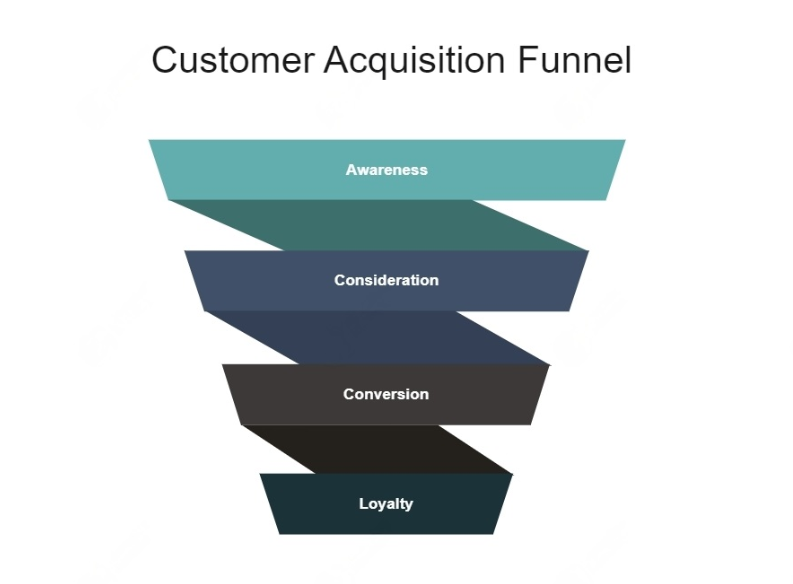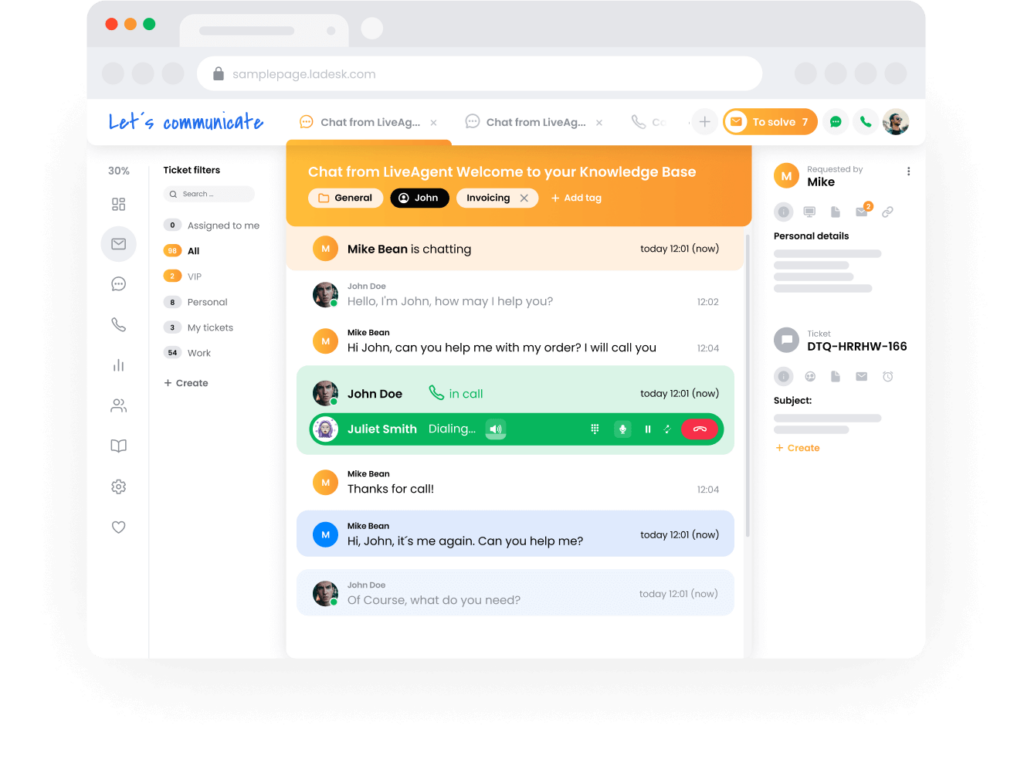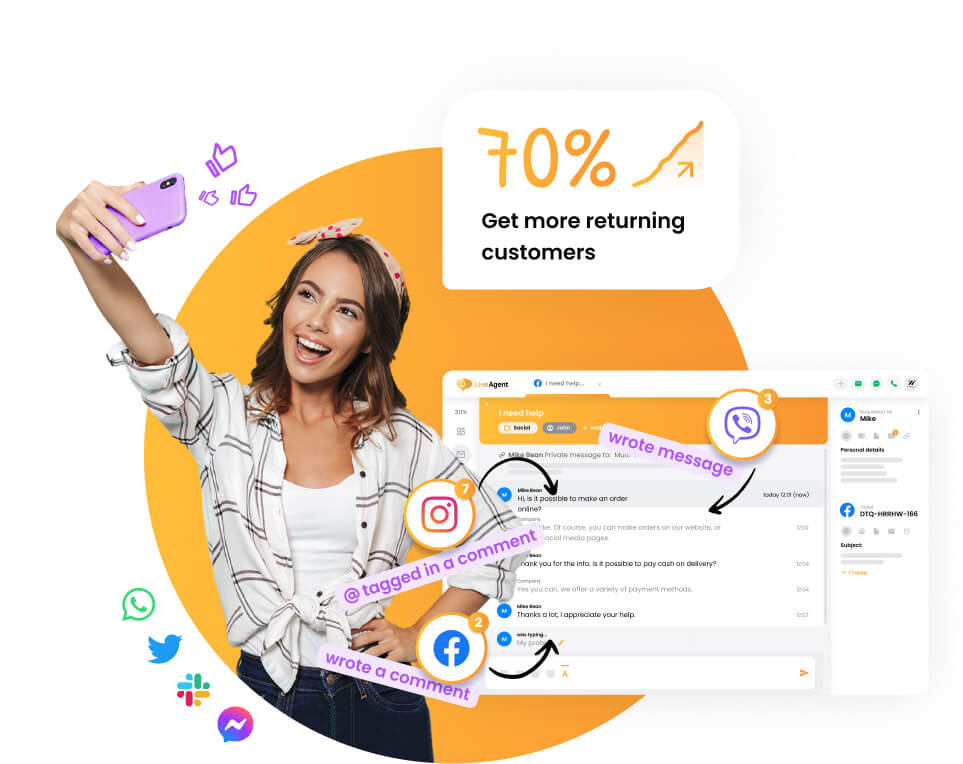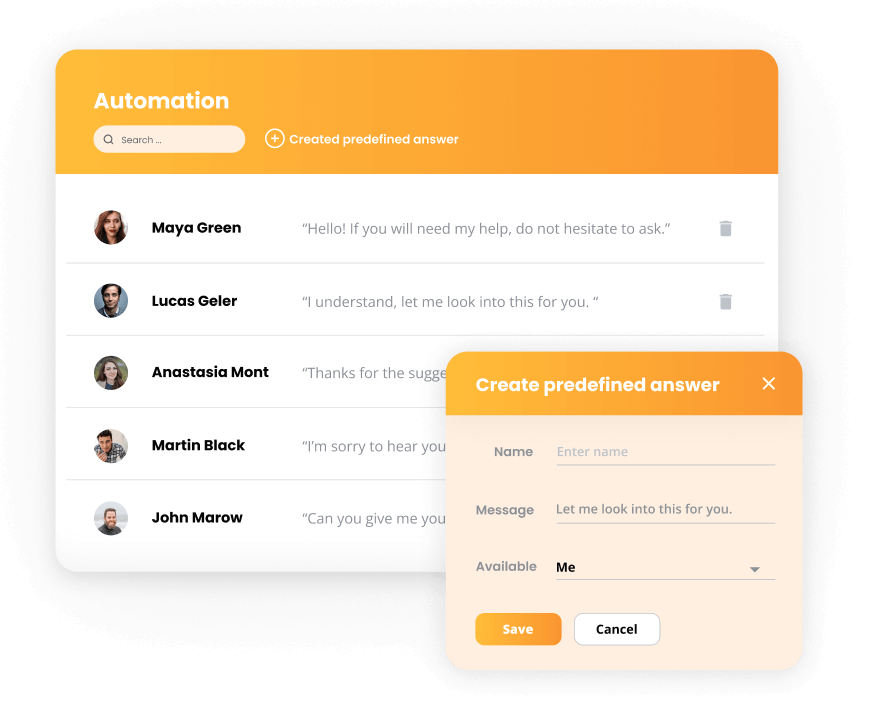Without a steady stream of prospective buyers, even the most innovative offerings can languish. Understanding the dynamics of customer acquisition is essential for sustainable growth.
Customer acquisition is not just a buzzword; it’s a critical process that encompasses various strategies and tactics aimed at increasing a company’s client base. Businesses must navigate an intricate funnel, moving potential customers from awareness to conversion, each stage requiring precise tactics and targeted efforts.
In this article, we will explore effective customer acquisition strategies, how to leverage channels like social media and SEO, and why utilizing tools like LiveAgent can significantly simplify these processes. Prepare to equip your business with the knowledge needed to thrive by mastering customer acquisition.
What is customer acquisition?
Customer acquisition is the process brands use to attract new customers or clients. It is crucial for driving sales and revenue. A successful strategy strengthens brand credibility and raises awareness.
To stay competitive, businesses need a systematic and sustainable acquisition plan. This plan should evolve with trends and changes in the market. Balancing customer acquisition with retention is key in today’s crowded marketplace.
A well-crafted acquisition strategy includes several steps. Here’s a simple list:
- Identify Target Audience: Understand who your ideal customer is.
- Craft Clear Messaging: Communicate your value effectively.
- Utilize Multiple Channels: Engage with customers through social media, email, and other platforms.
- Measure Success: Track metrics to see what works and what doesn’t.
Brands can assess the success of their strategies by measuring outcomes. Metrics like conversion rates and customer retention reveal insight. With these insights, businesses can refine approaches for better results.
Whether a small startup or a large corporation, customer acquisition is a vital part of growth. For efficient customer service solutions, consider using LiveAgent. It helps streamline interactions and enhances the customer experience.
Importance of customer acquisition for businesses
Customer acquisition is essential for boosting a company’s profits and increasing brand awareness. It lays a stable foundation for future growth. Without a steady stream of new customers, even the best retention strategies can cause stagnation rather than growth.
A robust customer acquisition strategy enables businesses to expand their customer base and enhance competitiveness. It also helps in increasing market share. By prioritizing customer acquisition, businesses stay relevant and adaptable to changing market dynamics.
Here are key reasons why customer acquisition is important:
- Profit Boost: More customers mean more sales and higher profits.
- Brand Awareness: Gaining new customers spreads brand recognition.
- Market Share: A bigger customer base leads to greater market presence.
- Growth Foundation: New customers support long-term business growth.
Developing effective acquisition strategies transforms this process from a game of chance into a systematic approach. This approach is crucial for attracting and converting potential customers.
To succeed in customer acquisition, consider using tools like LiveAgent. LiveAgent helps businesses streamline communications with potential clients, making the customer acquisition process smoother and more efficient, ensuring sustained growth and success.
The Customer acquisition funnel explained
The customer acquisition funnel visualizes a customer’s journey from brand awareness to a final purchase. This funnel is crucial for businesses to understand how potential buyers transition through each stage. Comprised of three stages—awareness, consideration, and conversion—it helps companies develop strategies to guide potential customers seamlessly from one stage to the next.

Businesses employ a range of acquisition channels like email marketing, social media, and paid ads. These channels target buyer personas strategically at different touchpoints of their journey. By optimizing this funnel, organizations can create tailored marketing and sales strategies, effectively boosting their customer acquisition success.
Below, we explore each stage of the customer acquisition funnel in detail.
Awareness: The first stage of customer acquisition
The awareness stage is where potential customers first learn about a brand or product. Marketing activities like advertising and word of mouth play a pivotal role here. The aim is to generate leads from a broad audience who show interest but aren’t yet ready to purchase.
Social media and content marketing are key channels for building awareness. Tactics like hashtags and engaging content that resonates with target audiences can amplify brand exposure. Setting a strong foundation during this stage is vital for moving prospects toward consideration and eventual conversion.
Consideration: nurturing potential customers
In the consideration stage, businesses nurture leads by offering compelling content in different formats, such as blog posts and videos. This content engages potential customers by providing valuable information tailored to their needs and interests.
Visualizing customer experiences with a journey map is essential to spot any gaps or friction points. Testing, user research, and feedback help refine these strategies. Additionally, automation and artificial intelligence tools optimize customer acquisition by enhancing advertising campaigns and improving relationship management.
Conversion: turning prospects into buyers
The conversion stage is where prospects become buyers. Acquiring new customers provides insights into their preferences, helping businesses refine products and services. Email marketing in this stage is crucial for relationship-building and securing conversions through targeted campaigns.
Segmenting emails based on user behavior personalizes the experience, increasing conversion likelihood. Clear identification of the target audience’s needs and pain points is crucial for effective strategies. Utilizing combined channels like organic search and content marketing can efficiently convert potential customers into loyal buyers.

Understanding and implementing the customer acquisition funnel through these stages is essential for any organization looking to grow. Using tools like LiveAgent can greatly enhance communication and streamline the customer acquisition process, making it easier and more efficient to acquire and convert new customers.
Key customer acquisition channels
Customer acquisition is crucial for any business. It involves understanding and reaching your ideal buyers through various channels. These include your website, blog, email marketing, social media, events, paid ads, customer support, and referrals. Each channel plays a vital role in guiding potential customers through the stages of the acquisition funnel—from awareness to conversion. Effective use of these channels can significantly enhance your outreach and customer engagement.
Search Engine Optimization (SEO)
SEO helps you position your brand in front of potential customers by optimizing your website content to attract unpaid, organic traffic from search engines. Since nearly 70% of online experiences begin with a search engine query, it’s crucial to rank high on search results. In fact, about 75% of users don’t go past the first page. By conducting keyword research and implementing on-page optimization, businesses can align their content with the needs of their target audience, ultimately achieving better online visibility and attracting new customers.
Content marketing strategies
Content marketing involves crafting and sharing valuable content, such as blogs, videos, and social posts. This strategy helps engage and attract a target audience by addressing their needs and pain points. By nurturing prospects through the acquisition funnel—from awareness to retention—content marketing can establish your brand as an industry authority. High-quality, relevant content not only drives organic traffic but also increases brand awareness and conversion rates. It is crucial to provide genuine value and include clear calls to action in every piece of content.
Social media marketing approaches
Social media marketing helps enhance brand awareness and create emotional connections with potential customers. Businesses can use organic content to naturally engage users or opt for paid ads to increase visibility on platforms like LinkedIn, Instagram, and Facebook. Understanding your target audience’s demographics allows you to tailor content that resonates with them. Engaging content, social media ads, and active interaction can drive traffic to your websites and generate leads, expanding your reach in a casual, interactive setting.

Email marketing techniques
Email marketing is a powerful, cost-effective acquisition tool that can significantly influence purchasing decisions. Businesses can use dynamic content to personalize messages by including the recipient’s name or job title. Trigger marketing flows based on user behavior help create a cohesive experience, guiding recipients through the acquisition funnel. Email newsletters help maintain engagement, keep your brand top-of-mind, and nurture leads into paying customers.
Referral programs and incentives
Referral programs encourage existing customers to bring in new ones by offering rewards or discounts. This type of word-of-mouth marketing is particularly effective for B2C companies. To run a successful program, businesses need a satisfied customer base ready to participate. Offering valuable rewards can motivate customers to share the company, thus boosting new customer acquisition efforts.
Incorporating a sophisticated help desk system such as LiveAgent can seamlessly integrate these channels, ensuring potential customers receive timely support and solutions. This will foster customer relationships and increase customer satisfaction and loyalty.
Measuring customer acquisition cost (CAC)
Measuring Customer Acquisition Cost (CAC) is essential for understanding how much you spend to gain new customers. To find your CAC, divide your total marketing and sales costs by the number of new customers acquired. It includes expenses like advertising, employee salaries, and content creation.
Costs and efficiency can vary widely. For instance, CAC benchmarks show that travel industry costs are often as low as $7, whereas technology software could soar to $395. This illustrates different customer acquisition expenses across sectors.
In recent years, CAC has risen by nearly 50%, emphasizing the need to manage these expenses wisely. Effective methods include content marketing, SEO, social media, and email marketing. These metrics help assess which strategies offer the best return on investment. Keeping an eye on these numbers ensures you don’t overspend while striving to expand your customer base.
Understanding customer lifetime value (LTV)
Understanding Customer Lifetime Value (LTV) is crucial for any business. LTV represents the total worth of a customer during their entire relationship with a company’s products and services. It’s a key metric, especially for businesses with recurring revenue models like subscription services. LTV helps identify the most profitable customers.
To assess the effectiveness of marketing and sales efforts, compare the customer acquisition cost (CAC) to LTV. Ideally, businesses should aim to recover CAC within a year of acquiring a customer. A higher LTV suggests greater business value, highlighting that retaining existing customers is generally more cost-effective than acquiring new ones.
Key Factors Affecting LTV:
- Customer Retention Rate: Higher retention increases LTV.
- Customer Churn Rate: Lower churn positively impacts LTV.
- Purchase Frequency and Value: Regular purchases at higher values boost LTV.
By focusing on these factors, businesses can improve LTV and overall business health.
The relationship between CAC and LTV
The relationship between Customer Acquisition Cost (CAC) and Customer Lifetime Value (LTV) is crucial for assessing the profitability of customer acquisition strategies. LTV measures the total revenue a business expects from a customer during their relationship. CAC represents the cost of acquiring that customer.
A useful metric to evaluate this relationship is the LTV/CAC ratio. Ideally, this ratio should be above 3.0, showing a good return on investment in customer acquisition. This suggests that the business is efficiently turning its marketing spend into customer revenue.
Table: LTV/CAC Ratio
| LTV/CAC Ratio | Interpretation |
|---|---|
| Above 3.0 | Healthy investment balance |
| Below 3.0 | Potential financial concern |
Brands should strive to recover CAC within a year to ensure sustainable marketing expenses. If CAC exceeds LTV, this could indicate financial distress, as it may lead to operating at a loss. However, some businesses focused on rapid user growth might temporarily prioritize CAC over LTV, especially in the early stages. For long-term success, balancing these metrics is essential.
Best practices for effective customer acquisition
This involves defining the ideal customer based on demographics, behaviors, and preferences. By knowing who your customers are, you can tailor your marketing efforts to attract them effectively. A well-rounded acquisition strategy not only helps bring in new customers but also retains them, fostering growth and ensuring long-term success. Connecting with prospects in meaningful ways, aligning solutions with their needs, and using integrated customer data are essential steps in this process.

Moreover, balancing acquisition with retention is vital for sustainable growth. Bringing in new customers offsets churn and supports business expansion. One tool that aids in achieving this balance is LiveAgent. It offers a powerful solution for managing customer interactions efficiently, ensuring satisfaction while nurturing new leads.
Creating targeted marketing campaigns
Creating targeted marketing campaigns means reaching the right audience with messages that resonate. Identifying your target market helps in forming campaigns that align with your business growth goals. Personalization and value-added content can turn leads into long-term clients. Digital marketing allows for precise tracking of acquisition efforts, helping discover scalable and effective tactics. Engaging prospects through various channels like PPC ads, email marketing, and partner referrals forms a robust strategy for gaining new customers.
Table: Customer Acquisition Channels
| Channel | Description |
|---|---|
| PPC Ads | Pay-per-click advertisements for immediate visibility |
| Email Marketing | Direct communication with personalized content |
| Partner Referrals | Leveraging partner networks to reach new audiences |
Engaging content creation
Engaging content is key to drawing in and holding the attention of your audience. By creating valuable content like blog posts and videos, you not only introduce potential customers to your brand but also establish authority in your industry. A successful content strategy includes clear calls to action, motivating audience engagement and conversion at every stage of the acquisition funnel. Feedback tools, like rating widgets, provide insights into audience preferences, helping refine content to better resonate with the target market.
Utilizing data analytics for optimization
Data analytics plays a central role in optimizing customer acquisition strategies. By examining customer behavior and feedback, businesses can enhance campaign effectiveness. AI-assisted tools now forecast market trends, guiding optimization efforts. Success in customer acquisition often hinges on metrics like conversion rates, CAC, and CLV, which help evaluate and refine strategies.
Tracking new customer acquisition rates over time reveals performance trends and growth opportunities. By automating routine digital marketing tasks, organizations can focus on analyzing and enhancing their acquisition strategies. LiveAgent can support these efforts by streamlining customer interactions and providing insights into customer behavior and preferences, driving better results in acquisition campaigns.
Attract more customers with ease
Boost your customer base with smart acquisition strategies. Reach the right audience, increase conversions, and grow your business effortlessly.
Common challenges in customer acquisition
Customer acquisition can be a challenging task due to several factors. One of the main hurdles is competition, as numerous businesses aim to capture the same audience. Standing out requires distinct strategies and offers.
Another challenge is brand awareness. New or less recognized businesses struggle to make their services known. Without awareness, attracting customers becomes harder.
High costs associated with customer acquisition can also impact profit margins. Many businesses rely on paid advertising, which can be expensive. This is especially true if conversion rates are low.
In addition, long sales cycles can be problematic. Extended timeframes can delay converting leads into customers, requiring more resources and patience.
Finally, an evolving market landscape necessitates adaptive strategies. Successful acquisition must align with current trends and customer preferences.
To tackle these challenges, it’s crucial to employ effective strategies. Here’s a quick list:
- Differentiate your offering.
- Enhance brand visibility.
- Optimize spending on acquisition.
- Streamline sales processes.
Utilizing tools like LiveAgent can simplify these tasks, helping businesses efficiently manage customer acquisition and retention.
| Challenge | Solution Hint |
|---|---|
| High Competition | Differentiation strategies |
| Low Brand Awareness | Enhance visibility efforts |
| High Acquisition Costs | Optimize spending |
| Long Sales Cycles | Streamline sales processes |
| Evolving Markets | Adapt to trends and behaviors |
Adapting to market changes for success
Adapting to market changes is crucial for successful customer acquisition. Businesses must identify the right audience and target them with effective marketing campaigns. Regularly reevaluating customer acquisition models helps in staying competitive as customer behaviors and market conditions evolve.
A focus on customer acquisition cost (CAC) is essential. It allows businesses to refine strategies and optimize resource allocation. This focus leads to improved growth outcomes. Automation tools can streamline efforts by creating customized experiences for potential customers. This increases acquisition effectiveness.
A mix of long-term sustainable practices is key. Relying solely on short-term initiatives often fails to yield lasting results. Strategies should be tailored to balance immediate needs with future growth.
Here’s a simple approach to adapt your strategy:
- Continuously monitor market trends.
- Evaluate and adjust your customer acquisition models regularly.
- Invest in automation tools for personalized customer experiences.
- Keep track of CAC to refine and improve strategies.
By adapting effectively, businesses can enhance competitiveness, increase market share, and achieve sustained success. Use LiveAgent as an effective tool to manage customer interactions and streamline your acquisition process.
Conclusion and next steps
In conclusion, a well-rounded customer acquisition strategy is crucial for business success. It helps attract new customers and keeps existing ones engaged, driving long-term growth. To measure the effectiveness of different acquisition channels, using a lead management and sales enablement tool is important.
Developing your strategy involves several key steps:
- Identify your target audience.
- Understand their needs.
- Set clear goals and objectives.
- Continuously optimize performance metrics.
Balancing acquisition with retention ensures sustainable growth by reducing churn and creating a stable customer base.
Next Steps:
- Define and segment your target market.
- Use data analytics to refine your strategies.
- Implement a robust tool like LiveAgent for efficient lead management.
- Test and adapt your strategy to find what works best for your business.
To experience an effective tool firsthand, consider trying LiveAgent’s 30 days free trial. This will provide you with valuable insights and help streamline your customer acquisition efforts.
Attract more customers with ease
Boost your customer base with smart acquisition strategies. Reach the right audience, increase conversions, and grow your business effortlessly.
Frequently Asked Questions
What is an example of customer acquisition?
Most marketing activities businesses engage in are with the prospect of attracting new customers in mind. For example, a visually appealing introductory video with a clear call-to-action may convince a visitor to sign up for a free trial and eventually become a paying customer.
Why is customer acquisition hard?
Customer acquisition requires you to deeply understand your potential customers and employ strategies that fit both your business and your target customer. Further, you’re always competing for the same customers with other companies. Finding what works for you is a matter of patience and testing.
What are the key challenges in customer acquisition?
The biggest challenge is understanding your audience’s constantly evolving needs and preferences so that you can respond accordingly, and stand out among the competition. The rising customer acquisition costs make continuously updating your strategy to make sure you’re not throwing money away, even more important than ever.
Is customer acquisition the same as customer experience?
No, but they are closely connected. Think of customer acquisition as the first step of getting a prospect to be your customer. On the other hand, customer experience includes all interactions, thoughts, feelings, and behaviors a customer has throughout their entire journey with your company.
Share this article
Customer loyalty and retention: Simple guide, strategies, and metrics
Unlock the secrets of customer loyalty and retention with our comprehensive guide. Discover 12 powerful strategies to transform one-time buyers into lifelong advocates, enhancing your business growth and sustainability. Learn about key metrics, KPIs, and practical tips to build and maintain lasting customer relationships. Visit now to ensure your business stands out and prospers in the long run!
Mastering Customer Service Analytics: Essential Techniques for Success
Master customer service analytics to boost satisfaction! Explore techniques, AI tools, and trends to optimize support and make data-driven decisions.

 Български
Български  Čeština
Čeština  Dansk
Dansk  Deutsch
Deutsch  Eesti
Eesti  Español
Español  Français
Français  Ελληνικα
Ελληνικα  Hrvatski
Hrvatski  Italiano
Italiano  Latviešu
Latviešu  Lietuviškai
Lietuviškai  Magyar
Magyar  Nederlands
Nederlands  Norsk bokmål
Norsk bokmål  Polski
Polski  Română
Română  Русский
Русский  Slovenčina
Slovenčina  Slovenščina
Slovenščina  简体中文
简体中文  Tagalog
Tagalog  Tiếng Việt
Tiếng Việt  العربية
العربية  Português
Português 








